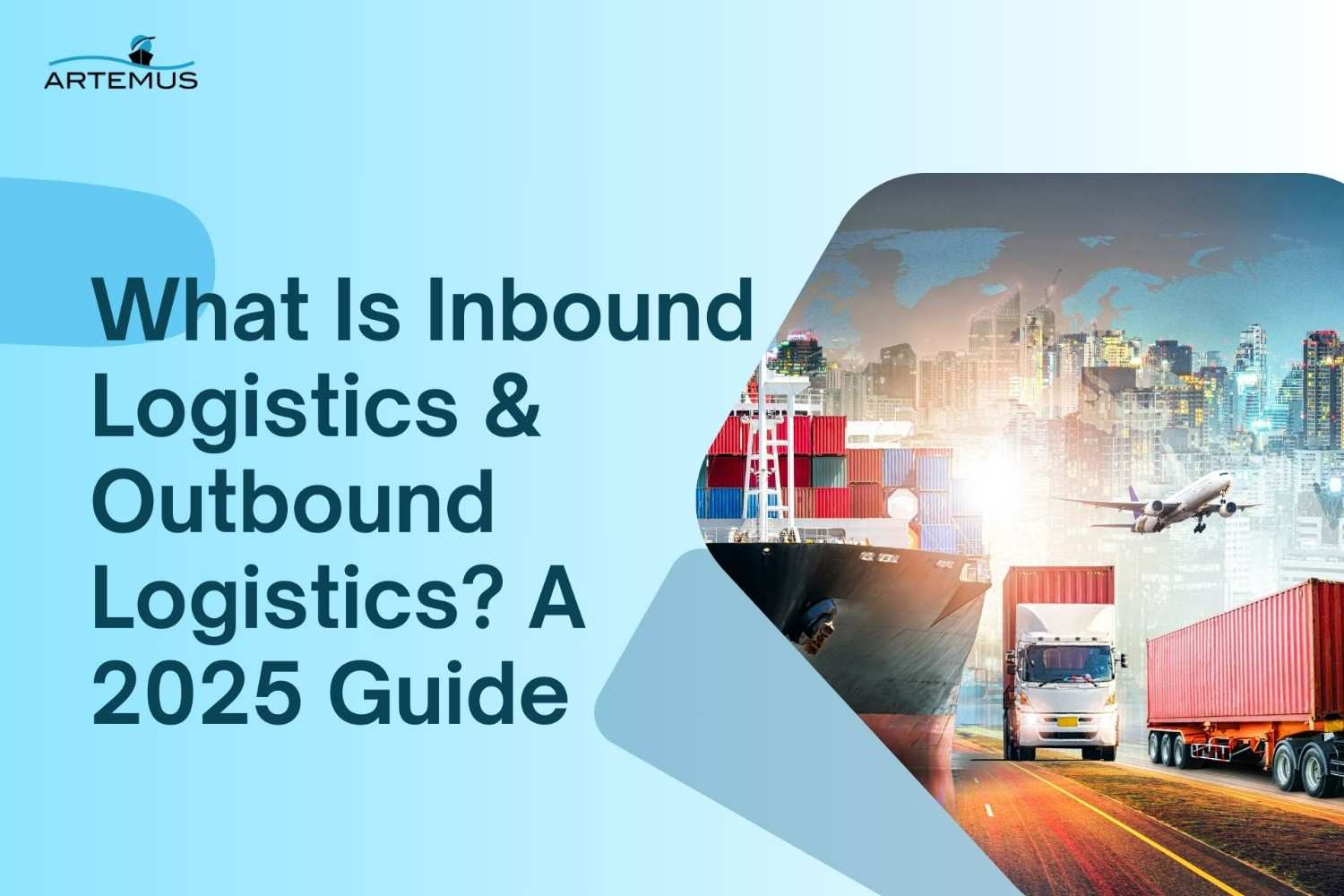
What Is Inbound Logistics & Outbound Logistics? A 2025 Guide
In the dynamic world of supply chain management, understanding the nuances of inbound and outbound logistics is crucial for operational
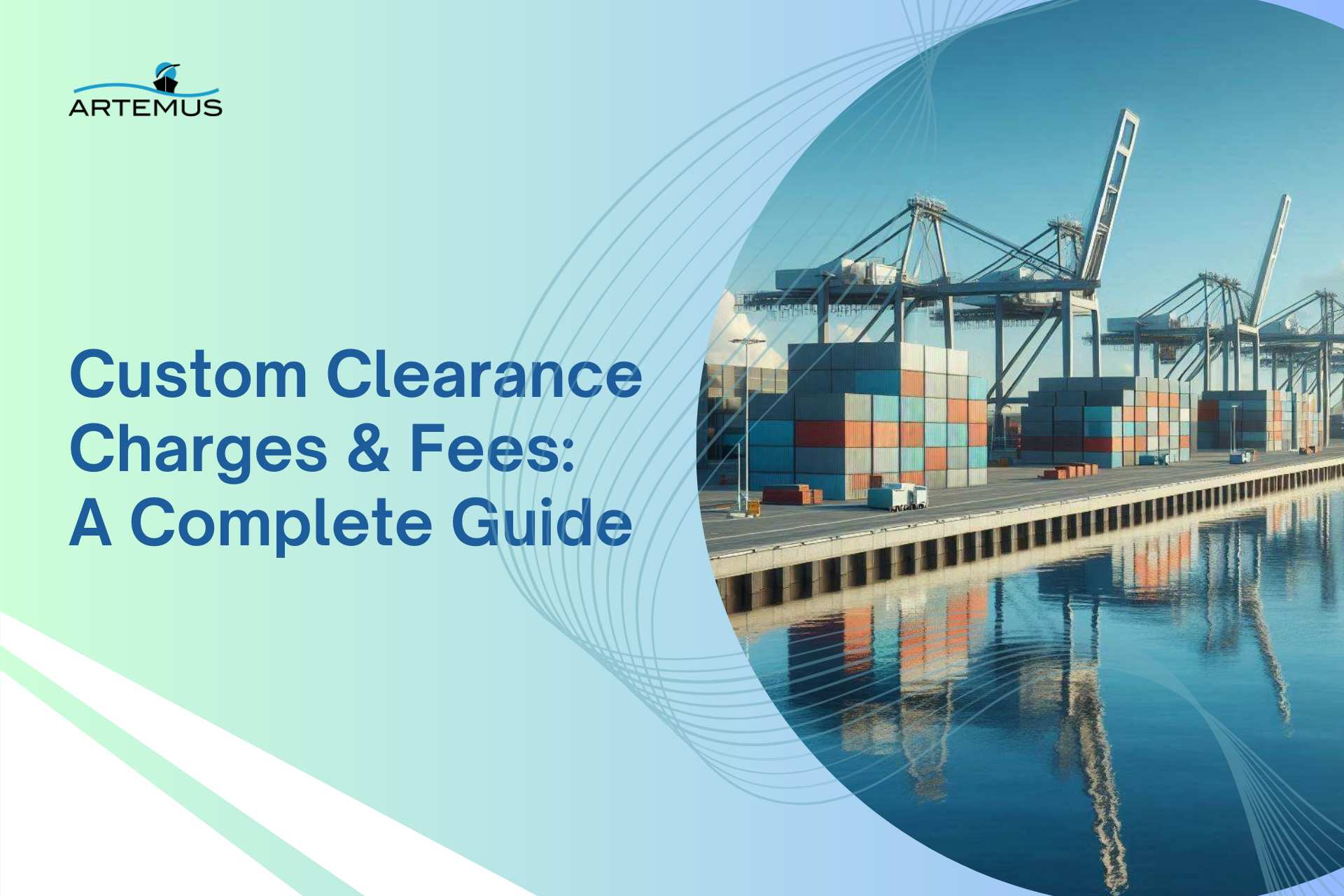
Custom clearance charges are essential fees incurred during the process of importing or exporting goods across international borders. These charges encompass various expenses levied by customs authorities, including duties, taxes, handling fees, and other regulatory costs. Efficiently managing customs clearance charges is crucial for businesses engaged in global trade to ensure compliance with customs regulations while minimizing costs and optimizing supply chain operations.
Additionally, Artemus Transportation Solution offers a comprehensive ISF (Importer Security Filing) and AMS (Automated Manifest System) software solution to facilitate seamless customs clearance processes. With Artemus, businesses can streamline the filing of mandatory documentation, automate data validation, and receive real-time updates, enhancing efficiency and accuracy in customs clearance operations.
Table Of Contents
Custom clearance charges, often referred to simply as clearance charges, are the fees levied by customs authorities for processing the import or export of goods across international borders. These charges are an integral part of the customs clearance process, which involves the verification, assessment, and approval of shipments to ensure compliance with applicable laws and regulations.
At its core, customs clearance is the process through which goods are inspected, documented, and authorized by customs officials before entering or leaving a country. This process is essential for maintaining the integrity of a country’s borders, protecting domestic industries, and ensuring the safety and security of its citizens.
Related: How Long Does Customs Clearance Take? Key Takeaways
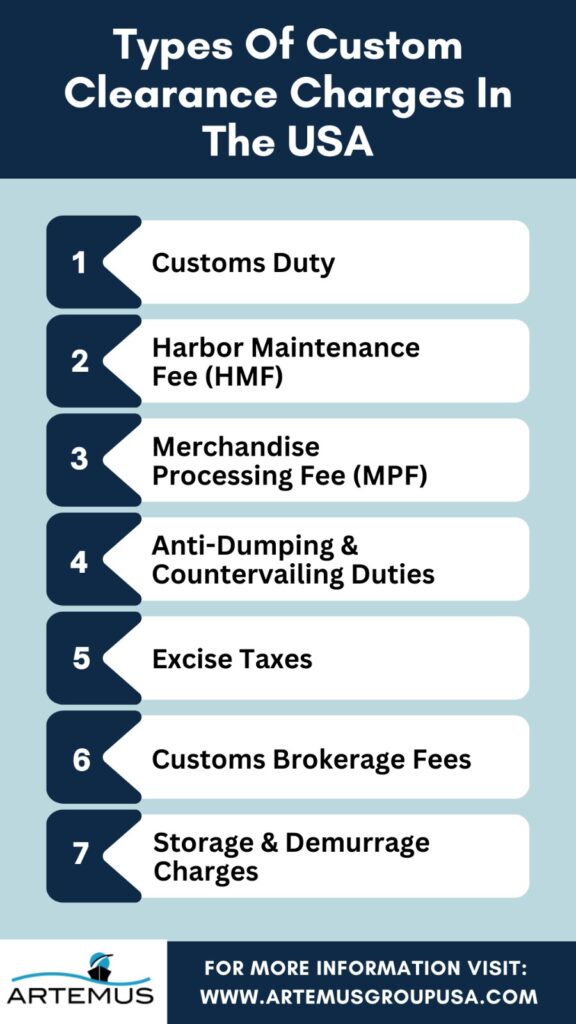
In the United States, customs clearance charges encompass a variety of fees and duties that are applied to imported goods as they undergo the customs clearance process. Understanding the types of customs clearance charges is essential for businesses engaged in international trade to accurately budget for importation costs and ensure compliance with customs regulations. Here are some of the key types of custom clearance charges in the USA:
Customs duty, also known as import duty, is a tax imposed by the U.S. government on imported goods. The duty rate is determined based on factors such as the type of goods, their country of origin, and their value. The Harmonized Tariff Schedule (HTS) categorizes goods into various tariff classifications, each with its duty rate.
The Harbor Maintenance Fee is assessed on imported cargo arriving at U.S. ports to fund the maintenance and operation of port facilities. The fee is calculated based on the value of the imported goods and is typically charged at a rate of 0.125% of the cargo’s value.
The Merchandise Processing Fee is a mandatory fee imposed by U.S. Customs and Border Protection (CBP) on most imported goods entering the United States. The fee is assessed based on the value of the imported merchandise, with a minimum fee and a maximum fee cap. As of 2024, the MPF rate is 0.3464% of the cargo’s value, with a minimum fee of $27.23 and a maximum fee of $528.33 per entry.
In cases where imported goods are determined to be sold in the U.S. at unfairly low prices or subsidized by foreign governments, anti-dumping and countervailing duties may be imposed to level the playing field for domestic industries. These duties are designed to offset the harm caused by unfair trade practices and can significantly increase the cost of imported goods.
Certain goods imported into the United States, such as alcoholic beverages, tobacco products, and motor vehicles, may be subject to excise taxes in addition to customs duty. Excise taxes are imposed on specific goods at the time of importation and are calculated based on factors such as quantity, volume, or weight.
Importers often enlist the services of customs brokers to assist with the customs clearance process. Customs brokers facilitate communication with CBP, ensure compliance with customs regulations, and handle documentation and paperwork on behalf of the importer. Customs brokerage fees vary depending on the services provided and the complexity of the clearance process.
If imported goods are held in storage at a port or warehouse while awaiting customs clearance, storage charges may apply. Demurrage charges may also be incurred if cargo is not picked up from the port within a specified time frame after arrival. These charges can accrue quickly and add to the overall cost of importing goods.
Understanding these types of customs clearance charges is crucial for importers to accurately estimate the total cost of importing goods into the United States and ensure compliance with customs regulations. Importers should work closely with customs brokers and logistics providers to navigate the customs clearance process efficiently and minimize the impact of these charges on their bottom line.
Related: Shipment Has Been Given A Release Status By Customs
Custom clearance charges are influenced by a variety of factors, each of which can impact the total cost of importing or exporting goods across international borders. Understanding these factors is essential for businesses engaged in global trade to accurately budget for custom clearance expenses and optimize their supply chain operations. Here are some of the key factors that influence custom clearance charges:
1. Value Of Goods: The value of the imported or exported goods is a primary determinant of customs clearance charges. Customs duties and taxes are often calculated as a percentage of the declared value of the goods. Higher-value items typically incur higher duty and tax obligations, leading to increased clearance charges.
2. Type Of Goods: The type of goods being imported or exported can significantly influence customs clearance charges. Some goods may be subject to specific regulations, restrictions, or additional fees based on their nature, composition, or intended use. For example, certain agricultural products, hazardous materials, or controlled substances may require specialized permits, inspections, or documentation, leading to higher clearance charges.
3. Country Of Origin Or Destination: The country of origin or destination of the goods can impact customs clearance charges due to trade agreements, tariff preferences, or geopolitical factors. Goods imported from countries with which the importing country has free trade agreements or preferential trade arrangements may qualify for lower duty rates or exemptions, reducing clearance charges. Conversely, goods from countries subject to trade sanctions or embargoes may face higher duties or additional compliance requirements, increasing clearance costs.
4. Tariff Classification: The classification of goods according to the Harmonized Tariff Schedule (HTS) plays a crucial role in determining customs clearance charges. Each product is assigned a specific tariff classification code based on its characteristics and intended use, which determines the applicable duty rates. Accurate classification of goods is essential to ensure compliance with customs regulations and avoid overpayment or underpayment of duties.
5. Customs Valuation: The method used to determine the customs value of imported goods can impact clearance charges. Customs authorities typically assess the value of goods based on the transaction value (the price paid or payable for the goods), adjusted for certain adjustments such as freight, insurance, and other incidental expenses. Discrepancies in valuation methods or discrepancies between the declared value and the customs-assessed value can result in additional scrutiny and potential penalties, affecting clearance charges.
6. Transportation Mode & Incoterms: The mode of transportation and the terms of sale (Incoterms) specified in the sales contract can influence custom clearance charges. Importers are responsible for arranging transportation and may incur additional charges such as freight, insurance, and handling fees. The chosen Incoterm determines the point at which the responsibility for goods and associated costs transfers from the seller to the buyer, impacting clearance charges accordingly.
7. Customs Brokerage Services: Importers often enlist the services of customs brokers or freight forwarders to navigate the customs clearance process efficiently. Customs brokerage fees vary depending on the services provided, the complexity of the clearance process, and the expertise of the broker. The choice of a customs broker can influence clearance charges and overall supply chain costs.
8. Compliance Requirements: Compliance with customs regulations, import/export controls, and other legal requirements can affect clearance charges. Failure to provide accurate documentation, comply with licensing or labeling requirements, or meet import/export restrictions can result in delays, fines, or other penalties, increasing clearance costs.
9. Volume & Frequency Of Shipments: The volume and frequency of shipments can impact custom clearance charges. Importers/exporters handling large volumes of goods or frequent shipments may negotiate preferential rates with customs brokers, carriers, or logistics providers, reducing clearance charges through economies of scale or volume discounts.
10. Special Customs Programs & Incentives: Various customs programs, such as bonded warehouses, foreign trade zones (FTZs), or duty drawback schemes, offer opportunities to mitigate customs clearance charges. These programs provide importers/exporters with alternatives for managing customs duties, taxes, and compliance requirements, potentially reducing clearance costs and improving supply chain efficiency.
Related: Customs Compliance Software: Key Benefits & Top Suggestions
Calculating custom clearance charges in the USA involves several steps and considerations, as the charges are influenced by various factors such as the value of the goods, applicable duty rates, taxes, and additional fees. Here’s a general guide on how to calculate custom clearance charges in the USA:
In addition to customs duty, imported goods may be subject to other charges and fees such as the Merchandise Processing Fee (MPF), Harbor Maintenance Fee (HMF), and any applicable taxes (e.g., value-added tax or excise tax).
These charges are typically calculated as a percentage of the customs value or the entered value of the goods and may have minimum or maximum fee caps.
It’s important to note that customs clearance charges can vary depending on factors such as the nature of the goods, the country of origin, and any applicable trade agreements or regulatory requirements. Importers should carefully calculate and budget for these charges to ensure compliance with customs regulations and avoid delays or penalties during the clearance process.
Related: ISF Filing: A Compliance-Related Guide & Software Solution
Minimizing customs clearance charges is crucial for businesses engaged in international trade to maintain competitiveness and profitability. Here are some effective tips to help reduce custom clearance charges:
Related:What Is HTS Code (Harmonized Tariff Schedule)? A Quick Guide
Artemus is an innovative ISF (Importer Security Filing) filing software designed to streamline the customs clearance process for importers and customs brokers in the USA. This cutting-edge software simplifies the filing of mandatory ISF documentation required by U.S. Customs and Border Protection (CBP) for ocean freight shipments.
With Artemus, users can efficiently submit accurate and timely ISF filings, ensuring compliance with CBP regulations and avoiding costly penalties for non-compliance. Its user-friendly interface and intuitive features make it easy to manage ISF filings for multiple shipments, helping businesses save time and resources while maintaining smooth logistics operations.
Artemus offers a comprehensive solution for ISF filing, providing users with advanced features such as automated data validation, real-time status updates, and customizable reporting tools. By leveraging Artemus, importers, and customs brokers can enhance their efficiency and accuracy in managing ISF filings, ultimately improving their overall customs clearance process.
Related: How To Check ISF Filing Status? A Step-By-Step Guide
A customs clearance fee is a charge imposed for the processing and verification of imported or exported goods by customs authorities, ensuring compliance with regulations and facilitating their entry or exit across international borders.
Customs clearance charges in India are typically paid through authorized banking channels or online platforms, where importers can make payments electronically via electronic funds transfer (EFT), online banking, or through designated bank branches.
The clearance entry fee is a charge levied by customs authorities for processing the documentation and entry of goods into a country, facilitating their clearance through customs and compliance with regulations.
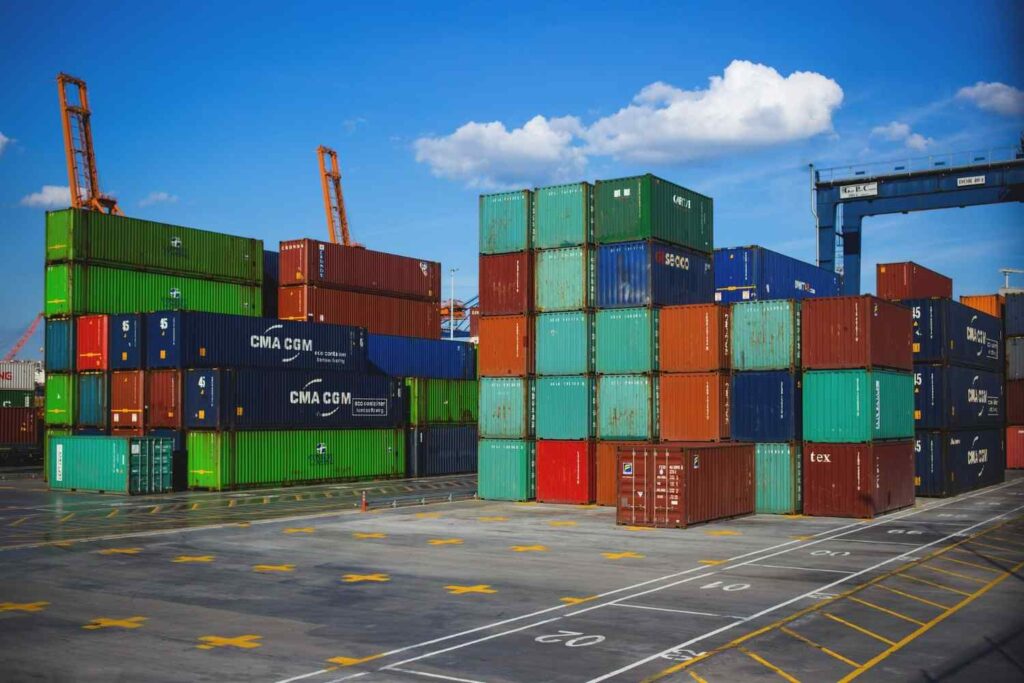
In conclusion, understanding and effectively managing customs clearance charges are essential aspects of international trade. These charges encompass various fees, duties, and taxes imposed by customs authorities during the import or export process. By carefully calculating and budgeting for custom clearance charges, businesses can ensure compliance with regulations while minimizing costs and optimizing supply chain operations.

In the dynamic world of supply chain management, understanding the nuances of inbound and outbound logistics is crucial for operational

In today’s interconnected world, businesses rely heavily on global trade to expand their markets, access new resources, and drive growth.
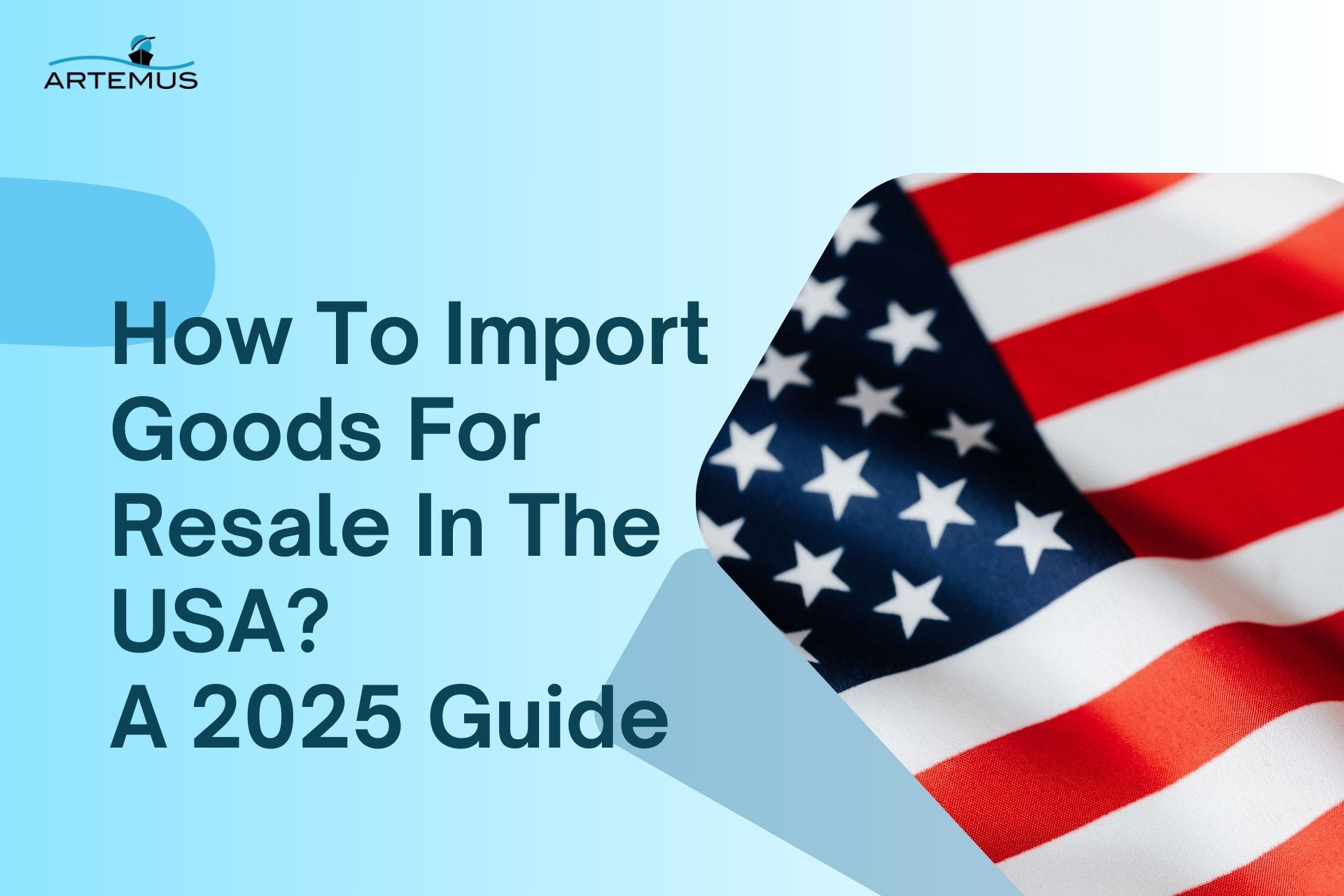
Importing goods for resale in the USA presents a lucrative business opportunity, but navigating the complexities of U.S. customs regulations,
Get In Touch
Artemus’ Software Solutions for ISF, AMS, Japan AFR, eManifest Canada, & Panama B2B filings.